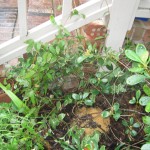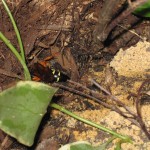 Overnight, a very strange dirt mound appeared in the planting bed next to the kitchen door. I noticed it immediately because the large pile of yellow sand clay granules contrasted well with my ebony bark mulch.
Overnight, a very strange dirt mound appeared in the planting bed next to the kitchen door. I noticed it immediately because the large pile of yellow sand clay granules contrasted well with my ebony bark mulch.
Off to one side was a half-inch diameter hole, so I knew right away some creature had come visiting. But which one? Too small for a mole – possibly a vole or field mouse. Was it friend or foe?
After I brushed the plants aside, what happened next shocked me…
I see a critter almost the size of a golf ball with wings and red legs emerge and toss aside more dirt!
Mystery solved – we have a Cicada Killer Wasp.
 Don’t be alarmed. In spite of its formidable size and burrowing habit, this wasp is unusually docile and has virtually no sting. Their venom is adapted to paralyzing insect prey, and (unless you’re highly allergic) not causing pain to pets or people.
Don’t be alarmed. In spite of its formidable size and burrowing habit, this wasp is unusually docile and has virtually no sting. Their venom is adapted to paralyzing insect prey, and (unless you’re highly allergic) not causing pain to pets or people.
If a cicada killer wasp burrow isn’t in an awkward place, best to leave them alone. Mother Nature uses Cicada killer wasps to manage the cicada insect population.
Cicada killer wasps are more of a nuisance and are considered yard pests for aesthetic reasons. The effects of their burrows are short-lived, and disappear with rain or watering. Cicada killer wasps emerge in July and August, mate and then dig burrows. Your property is attractive probably because it’s south-facing, well-drained and with large trees nearby.
Unhealthy lawns can also attract colonies of burrows further smothering the grass. The Extension folks say adequate lime and fertilizer applications with frequent watering promote a thick growth of turf and can usually eliminate a cicada killer wasp infestation in one or two seasons. (Their digging actually benefits by aerating the soil.)
How to control Cicada killer wasps the green way.
Still want to remove them? Don’t reach for the chemicals. I believe you are in more danger from pesticides applied to your yard to kill the wasps than from the Cicada killer wasps themselves.
Like me, if you catch their activity early, drive off the adults by flooding the infested area heavily with water, then placing a dowel in the hole (so you can find it again to add more water if needed). While Cicada killer wasps only inhabit disturbed places, they do not nest in soggy soils.
If you have an established burrow, wait until dark (they’re home for the night) and pour boiling water down the burrow (avoid spilling it on yourself of course). This can kill the adults, larvae, and pupae.
I’ve also heard diatomaceous earth can be a cheap and otherwise harmless insecticide. During the day (when the parents are out hunting cicada’s) use a turkey baster to shoot it down into the burrow. It kills by dehydrating the adult.
Cicadas (incorrectly called “locusts”) emerge from the soil every 2 to 17 years, but depending on the region, some are active every year. In May or June, the nymphs crawl to the trunk of a tree or some other object and cling there. Soon the insect molts into the winged adult stage, leaving behind the cast skin. Adults are active during daylight hours. (Which when the wasps hunt them.)
Cicada-killer wasp populations vary depending on the hatch or release of cicadas. It took me 50 years to see one, but this wasp occurs in all states east of the Rocky Mountains.
Got a Cicada killer wasp encounter you want to share? Type it below.

{ 10 comments… read them below or add one }
This is the first year I have seen the cicada wasp unfortunetly I saw them in my house. I don’t know how they get in. I think I would notice one if it came in when I opened the door. Would it be possible for them to burrow under my house (build on a slab) and get into my heat and air duct system? I have killed about 8 of them so far.
It sounds like they’re getting trapped some how. Good news, the last place a cicada killer wasp wants is to be indoors! True to their name, the females hunt outside for adult cicadas to feed to their young.
It’s unlikely they are living under your home since they seek out easily dug, well-drained soil in full sun for their burrows. They also like an unobstructed approach/departure for safe landings. Your heat/air system is self-contained and since you’re house is on a slab, your ducts would be in your attic.
These are all hints to help you find their burrow locations. For example, they could be nesting on the south-side of your house foundation. Once you find the tell-tale soil mounds, flood the burrows with water every day for a week or so. That discourages them from staying.
Many houses have cracks and bad connections between the framing and foundation. If a large insect can get inside, then you are probably losing valuable heating/air conditioning.
Maybe the cicada killer wasps have done you a kind of favor? They’ve shown you where to seal a leak and save a whole bunch of money!
As far as reading that the sting of the female cicada killer doesn’t hurt or the effects don’t last long is VERY WRONG. My left side was effected for several days. I was stung last summer trying to water my plants at night because the infestation was so bad in the backyard. They are in the front yard too. I enjoy nature but I would like to enjoy the backyard again. Haven’t been able to enjoy the backyard with the kids and dog like before. Oh, and our grass is thick and never excessively short. The neighbors do not seem to have as much problem with them. Of course, some of them are the ones that have the trees with the cicadas that attract the cicada killer wasps. If I could invite the wasps to their yard I would, to leave us alone.
Here are the key points from my post: 1) sunny sandy soils attract them so when they are active in the spring, flood the ground burrows because they hate a wet home. 2) If they are in your lawn, put your efforts into improving the soil so you produce a healthy thick lawn. They’ve moved in because the soils are easy to dig in that area. 3) I’m sorry but you may be sensitive to their venom; this is a wasp after all. They typically keep to themselves unless stepped on or get aggravated by something.
Our dog nearly died yesterday after getting stung by one of these, but we did not know what was wrong with him at the time. We found the burrows all over our yard today. He threw up and collapsed and was unresponsive. When we arrived at the vet he had very low blood pressure, white gums, and a high heart rate. Thank God I got him to the vet in time.
That couldn’t have been too pleasant an experience. Your dog must be super sensitive to bee venom.
I own a landscape company and have tried using pesticides to rid my customers lawns of cicada wasps. I didn’t like pouring chemicals all over the lawn with little results. I designed and manufactured a trap that catches the female using non-toxic glue. Once the female is gone the males leave the area. Please take a look at cicadawasptrap.com please if you like what you see please feel free to link our page. There are too many people abusing the use of pesticides.
Thanks John
We have been able to reduce infestations without pesticide usage. Using a trap from http://www.cicadawasptrap.com
Thanks John
I walk around my house very morning by 6 am to check for new burrows. If I see one, I flood the hole with water from the hose until the female emerges about 15 seconds later. She is obviously drowning. Then I squash her with a small shrub rake while continually hosing her. It is so fast and you will flush her out 100% of the time as long as she is inside the burrow at the time. No female, no eggs laid! Presto! Then I hose all the dirt away. This morning I found 4 new nests and killed all 4 females. The nests are so new that the wasps don’t even have time to hunt cicadas.
This is the second season of trying to reduce the number of these wasps. The most effective remedy I have found is to wait till night time and insert a funnel down the hole and dump two cups of a mixture of 1/2 ammonia and 1/2 water down the hole. Followed by putting a moth ball down the hole then cover the hole with soil and tamp it down. This is the first year I have encountered the female excavating the hole at night, so it has become a little tricky to do the ammonia thing followed by a moth ball without having the female coming out before you pour the ammonia mixture down. I have increased the amount to 3 cups if I see excavating activity. Also, I have used just a moth ball pushed down the hole and covering the hole with quite good luck. The only thing I found was that the wasp tried to push the moth ball out of the hole while I was trying to push it in, so be prepared with some type of stick that you can push the moth ball at a distance.